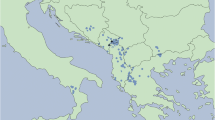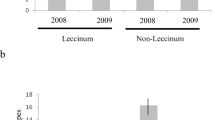Abstract
Primary successional vegetation gradients are characterized by changes in the soil microbial communities. However, information on possible shifts of the root endophytes along these gradients is scarce. The objective of the current study was to identify root endophytic fungi from a primary successional gradient on land uplift seashore of a geographically isolated island area. We applied a sequencing approach by amplifying the ITS region with fungal specific primers. We used mainly an isolate-based method, and to compare the abundance of culturable and unculturable endophytes, direct sequencing of one representative plant specimen Deschampsia flexuosa was also carried out. A total of 38 cultured endophytic strains were sequenced from Empetrum nigrum (Empetraceae), Vaccinium vitis-idaea (Ericaceae) and Deschampsia flexuosa (Poaceae). Out of these, 27 were identified as Phialocephala fortinii, three as Mollisia minutella, four as Phialophora sp., one as Ascomycetes sp. and three remained unidentified. The strains clustered into five clades in the phylogram, mostly irrespective of the successional stages and hosts from which they had been isolated. The early successional seashore dune ridge plants however, seemed to host a distinct fungal taxon, Phialophora sp. Culture-independent methods were applied on a root sample of a mid-successional Deschampsia flexuosa specimen and a total of 16 clones were randomly selected and sequenced. Out of 16 sequences, 13 were identified as unculturable strains and three showed closest similarity to a basidiomycete Cortinarius callisteus. The unculturable sequences were grouped into two main clades and were different from any culturable isolate in this study. Our results suggest that (i) P. fortinii dominates the isolate data at mid to late successional stages, (ii) roots of the ericaceous plants and the grass Deschampsia flexuosa are colonized by the same endophytic fungi in this ecosystem, and (iii) unculturable endophytes are common and potentially more abundant than the culturables. To our knowledge, this is the first report of the molecular phylogenies of the DSE in the mid-boreal zone and also the first report of the unculturable root endophytes of D. flexuosa.


Similar content being viewed by others
References
Addy HD, Piercey MM, Currah RS (2005) Microfungal endophytes in roots. Can J Bot 83:1–13
Aikio S, Väre H, Ohtonen R (2000) Soil microbial activity and biomass in the primary succession of a dry heath forest. Soil Biol Biochem 32:1091–1100
Alestalo J (1979) Land uplift and development of the littoral and aeolian morphology on Hailuoto, Finland. Acta Univ. Oul. A 82. Geol 3:109–120
Arnold AE (2007) Understanding the diversity of foliar endophytic fungi: progress, challenges and frontiers. Fungal Biol Rev 21:51–66
Ashkannejhad S, Horton TR (2006) Ectomycorrhizal ecology under primary succession on coastal sand dunes: interactions involving Pinus contorta, suilloid fungi and deer. New Phytol 169:345–354
Berch SM, Allen TR, Berbee ML (2002) Molecular detection, community structure and phylogeny of ericoid mycorrhizal fungi. Plant Soil 244:55–66
Berendse F, Lammerts EJ, Olff H (1998) Soil organic matter accumulation and its implications for nitrogen mineralization and plant species composition during succession in coastal dune slacks. Plant Ecol 137:71–78
Caldwell BA, Jumpponen A, Trappe JM (2000) Utilization of major detrital substrates by dark-septate, root endophytes. Mycologia 92:230–232
Chambers SM, Curlevski NJA, Cairney JWG (2008) Ericoid mycorrhizal fungi are common inhabitants of non-Ericaceae plants in a south-eastern Australian sclerophyll forest. FEMS Microbiol Ecol 65:263–270
Chelius MK, Triplett EW (2001) The diversity of Archaea and bacteria in association with the roots of Zea mays L. Microb Ecol 41:252–263
Duong LM, Jeewon R, Lumyong S, Hyde KD (2006) DGGE coupled with ribosomal DNA gene phylogenies reveal uncharacterized fungal phylotypes. Fungal Divers 23:121–138
Duong LM, McKenzie EHC, Lumyong S, Hyde KD (2008) Fungal succession on senescent leaves of Castanopsis diversifolia in Doi Suthep-Pui National Park, Thailand. Fungal Divers 30:23–36
Frøslev TG, Jeppesen TS, Læssøe T, Kjøller R (2007) Molecular phylogenetics and delimitation of species in Cortinarius section Calochroi (Basidiomycota, Agaricales) in Europe. Mol Phylogenet Evol 44:217–227
Gardes M, Bruns TD (1993) ITS primers with enhanced specificity for basidiomycetes-applications to the identification of mycorrhizae and rusts. Mol Ecol 2:113–118
Grünig CR, Sieber TN, Rogers SO, Holdenrieder O (2002) Spatial distribution of dark septate endophytes in a confined forest plot. Mycol Res 106:832–840
Grünig CR, McDonald B, Sieber TN, Rogers SO, Holdenrieder O (2004) Evidence for subdivision of the root-endophyte Phialocephala fortinii into cryptic species and recombination within species. Fungal Genet Biol 41:676–687
Hambleton S, Currah RS (1997) Fungal endophytes from the roots of alpine and boreal Ericaceae. Can J Bot 75:1570–1581
Hansen L, Knudsen H (eds) (1992) Nordic Macromycetes vol II. Nordsvamp, Copenhagen
Harney SK, Rogers SO, Wang CJK (1997) Molecular characterization of root endophytes. Mycol Res 101:1397–1404
Huang WY, Cai YZ, Hyde KD, Corke H, Sun M (2008) Biodiversity of endophytic fungi associated with 29 traditional Chinese medicinal plants. Fungal Divers 33:61–75
Hyde KD, Soytong K (2007) Understanding microfungi diversity—a critique. Cryptogam, Mycol 28:281–289
Hyde KD, Soytong K (2008) The fungal endophyte dilemma. Fungal Divers 33:163–173
Jumpponen A (1999) Spatial distribution of discrete RAPD phenotypes of a root endophytic fungus, Phialocephala fortinii, at a primary successional site on a glacier forefront. New Phytol 141:333–344
Jumpponen A, Trappe JM (1998) Dark septate endophytes: a review of facultative biotrophic root-colonizing fungi. New Phytol 140:295–310
Kalliola R (1973) Suomen kasvimaantiede. WSOY, Porvoo
Mandyam K, Jumpponen A (2005) Seeking the elusive function of the root-colonising dark septate endophytic fungi. Stud Mycol 53:173–189
Menkis A, Allmer J, Vasiliauskas R, Lygis V, Stenlid J, Finlay R (2004) Ecology and molecular characterization of dark septate fungi from roots, living stems, coarse and fine woody debris. Mycol Res 108:965–973
Ogura-Tsujita Y, Gebauer G, Hashimoto T, Umata H, Yukawa T (2008) Evidence for novel and specialized mycorrhizal parasitism: the orchid Gastrodia confuse gains carbon from saprotrophic Mycena. Proceedings of Royal Society 276:761–767
Ohtonen R, Pennanen T, Fritze H, Jumpponen A, Trappe J (1999) Ecosystem properties and microbial community changes in primary succession on a glacier forefront. Oecologia 119:239–246
Olff H, Huisman J, Van-Tooren BF (1993) Species dynamics and nutrient accumulation during early primary succession in coastal sand dunes. J Ecol 81:693–706
Pennanen T, Strömmer R, Markkola AM, Fritze H (2001) Microbial and plant community structure during primary soil formation. Scand J Forest Res 16:37–43
Piercey MM, Graham SW, Currah RS (2004) Patterns of genetic variation in Phialocephala fortinii across a broad latitudinal transect in Canada. Mycol Res 108:955–964
Pirttilä AM, Hirsikorpi M, Kämäräinen M, Jaakola L, Hohtola A (2001) DNA isolation methods for medicinal and aromatic plants. Plant Mol Biol Rep 19:273a–f
Promputtha I, Lumyong S, Dhanasekaren V, McKenzie EHC, Hyde KD, Jeewon R (2007) A phylogenetic evaluation of whether endophytes become saprotrophs at host senescence. Microb Ecol 53:579–590
Read DJ (1989) Mycorrhizas and nutrient cycling in sand dune ecosystems. P Roy Soc Edinb B96:80–110
Rungjindamai N, Pinruan U, Choeyklin R, Hattori T, Jones EBG (2008) Molecular characterization of basidiomycetous endophytes isolated from leaves, rachis petioles of the oil palm, Elaeis guineensis, in Thailand. Fungal Divers 33:139–161
Saikkonen K, Faeth SH, Helander M, Sullivan TJ (1998) Fungal endophytes: a continuum of interactions with host plants. Annu Rev Ecol Syst 29:319–343
Sánchez Márquez S, Bills GF, Zabalgogeazcoa I (2007) The endophytic mycobiota of the grass Dactylis glomerata. Fungal Divers 27:171–195
Sánchez Márquez S, Bills GF, Zabalgogeazcoa I (2008) Diversity and structure of the fungal endophytic assemblages from two sympatric coastal grasses. Fungal Divers 33:87–100
Schulz B, Boyle C (2005) The endophytic continuum. Mycol Res 109(6):661–686
Seena S, Wynberg N, Bärlocher F (2008) Fungal diversity during leaf decomposition in a stream assessed through clone libraries. Fungal Divers 30:1–14
Sharples JM, Chambers SM, Meharg AA, Cairney JWG (2000) Genetic diversity of root-associated fungal endophytes from Calluna vulgaris at contrasting field sites. New Phytol 148:153–162
Shenoy BD, Jeewon R, Hyde KD (2007) Impact of DNA sequence-data on the taxonomy of anamorphic fungi. Fungal Divers 26:1–54
Smith SE, Read DJ (1997) Mycorrhizal symbiosis. Academic, San Diego
Tamura K, Dudley J, Nei M, Kumar S (2007) MEGA4: Molecular Evolutionary Genetics Analysis (MEGA) software version 4.0. Mol Biol Evol 24:1596–1599
Tao G, Liu ZY, Hyde KD, Yu ZN (2008) Whole rDNA analysis reveals novel and endophytic fungi in Bletilla ochracea (Orchidaceae). Fungal Divers 33:101–122
Thompson JD, Gibson TJ, Plewniak F, Jeanmougin F, Higgins DG (1997) The ClustalX windows interface: flexible strategies for multiple sequence alignment aided by quality analysis tools. Nucleic Acids Res 25:4876–4882
Thongkantha S, Jeewon R, Vijaykrishna D, Lumyong S, McKenzie EHC, Hyde KD (2009) Molecular phylogeny of Magnaporthaceae (Sordariomycetes) with a new species, Ophioceras chiangdaoense from Dracaena loureiroi in Thailand. Fungal Divers 34:157–173
Vanderkoornhuyse P, Baldauf SP, Leyval C, Straczek J, Young JPW (2002) Extensive fungal diversity in plant roots. Science 295:2051
Vartiainen T (1980) Succession of island vegetation in the land-uplift area of the northernmost Gulf of Bothnia, Finland. Acta Botanici Fennici 115:1–105
Vermeer M, Kakkuri J (1988) Land uplift and sea level variability spectrum using fully measured monthly means of tide gauge readings. Finn Mar Res 256:3–76
Villareal-Ruiz L, Anderson IC, Anderson IJ (2004) Interaction between and isolate from the Hymenoscyphus ericae aggregate and roots of Pinus and Vaccinium. New Phytol 164:183–192
Vrålstad T (2004) Are ericoid and ectomycorrhizal fungi part of a common guild? New Phytol 164:7–10
Vrålstad T, Myhre E, Schumacher T (2002) Molecular diversity and phylogenetic affinities of symbiotic root-associated ascomycetes of the Helotiales in burnt and metal polluted habitats. New Phytol 155:131–148
Wang Y, Guo LD, Hyde KD (2005) Taxonomic placement of sterile morphotypes of endophytic fungi from Pinus tabulaeformis (Pinaceae) in northeast China based on rDNA sequences. Fungal Divers 20:235–260
Wang Z, Johnston PR, Takamatsu S, Spatafora JW, Hibbett DS (2006) Toward a phylogenetic classification of the Leotiomycetes based on rDNA data. Mycologia 98:1065–1075
White TJ, Bruns T, Lee S, Taylor J (1990) Amplification and direct sequencing of fungal ribosomal RNA genes for phylogenetics. In: Innis MA, Gelfand DH, Snisky JJ, White JJ (eds) PCR protocols: a guide to methods and applications. Academic, San Diego, pp 315–322
Zhu GS, Yu ZN, Gui Y, Hyde KD, Liu ZY (2008) A novel technique for isolating orchid mycorrhizal fungi. Fungal Divers 33:123–137
Zijlstra JD (2006). Organic nitrogen uptake and endophytic, mutualistic fungi in Dutch heathland ecosystems. PhD thesis, University of Wageningen, Netherlands
Acknowledgements
We thank Hui Nan for cleaning the root samples. This study was financed by SITRA, EU 7th FP Marie Curie Actions (94961), Kone Foundation and the Academy of Finland (projects # 122 092, 129852, 113607 and 118569).
Author information
Authors and Affiliations
Corresponding author
Rights and permissions
About this article
Cite this article
Tejesvi, M.V., Ruotsalainen, A.L., Markkola, A.M. et al. Root endophytes along a primary succession gradient in northern Finland. Fungal Diversity 41, 125–134 (2010). https://doi.org/10.1007/s13225-009-0016-6
Received:
Accepted:
Published:
Issue Date:
DOI: https://doi.org/10.1007/s13225-009-0016-6




